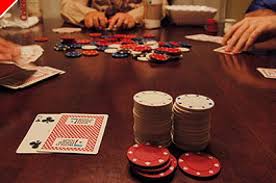In investing, as in poker, following rules works best

AT THE annual World Series of Poker, which begins this week in Las Vegas, the main event is the no-limit Texas hold ’em tournament. In the course of two weeks of gruelling knock-out play, several thousand players are whittled down to just two, playing “heads-up” for one of the WSOP’s coveted bracelets.
In last year’s final hand, both players had pushed all their chips in, with five shared cards yet to be dealt. Scott Blumstein, who held Ace-Deuce, was a big underdog against Daniel Ott, who held Ace-Eight. With one card to come, Mr Blumstein’s hand had not improved. His chances had narrowed to 7%. Of the remaining 44 cards, only one of the other three deuces could give him victory.
Get our daily newsletter
Upgrade your inbox and get our Daily Dispatch and Editor’s Picks.
The cards—and thus the odds of winning or losing—were known to both players, because they had already committed all their chips. Poker is not usually like this. Winning depends not only on your cards but on the unseen cards held by other players, on your ability to deceive them by your betting policy and on their ability in turn to deceive you. Fear and greed induce errors. In short, there is uncertainty. All this is also true of investing. The truly talented are able to read complex situations to their advantage. But there are ways for the less gifted to succeed—in both poker and investing.
They can start by being aware of the ludic fallacy. This is how Nassim Nicholas Taleb, an author, refers to the belief that risk in financial markets can be calculated as if it were a game with known odds. If you throw a pair of fair dice, you cannot know how they will land. But you do know some things. There are 36 possible pairs of numbers. Some totals are more likely than others. There are six ways to throw a seven, for instance, but only one way to throw either a two or a 12.
It is tempting to think that investing is like this—that the risks are calculable in advance. They are not. Investment returns are highly uncertain and irregular. Extreme events, such as market crashes, are more frequent than you would expect if dice games were your model of the world. After repeated rolls, dice throws fit a pattern that is known beforehand. In markets, almost anything can happen.
That is also true of poker. Each player has to live with uncertainty: about the cards opponents hold; about their betting strategy; about their understanding of your betting strategy; and even their grasp of the game. Emotions come into play. Players fold winning hands because an aggressive bluff makes them fear losing. And players call bets with losing hands out of greed for a big pot. The best players, like the best investors, seem to thrive on uncertainty. They look for betting patterns or for “tells” (expressions or hand movements) that betray the strength or weakness of an opponent’s hand. They make uncertainty work for them. They find spots where a big bluff is hard for an opponent to call.
For the rest of us, says Aaron Brown, a quantitative analyst and author of “The Poker Face of Wall Street”, a sound principle is to settle on a basic strategy and stick to it. In poker that means choosing in advance which starting hands you will play in each table position and deciding how you will bet should those hands improve when the shared cards are dealt.
The policy also works in investment. A simple strategy is to allocate a fixed portion of your wealth to different assets—half in a broad index of stocks, say, and half in bonds—and to “rebalance” every so often so that the weights are kept constant. An advantage is that you will automatically sell assets that have become dearer and buy assets that have become cheaper. “It turns out that any simple fixed-weight allocation works well,” writes Andrew Ang, of BlackRock, in his book, “Asset Management”.
Though simple in principle, a rules-based approach is difficult to follow in practice. It is hard to stay disciplined when your opponents in poker repeatedly draw the improbable cards they need to beat your strongest hands. A player is said to be “on tilt” when frustration at bad luck leads him to abandon his strategy. Investors are prone to similar sorts of errors when things go against them. “Having a non-stupid strategy and sticking to it will leave you better off than most people,” says Mr Brown.
Bad luck is part of the game. The best you can do is to try to make the right decisions given the inevitable uncertainty. In the final hand of the WSOP main event last year, Mr Ott made the right decision when he called Mr Blumstein’s bet. The odds favoured him. And they continued to until the moment when the dealer turned over the final card—a deuce.
Economist.com/blogs/buttonwood
This article appeared in the Finance and economics section of the print edition under the headline “Lessons from Las Vegas”










